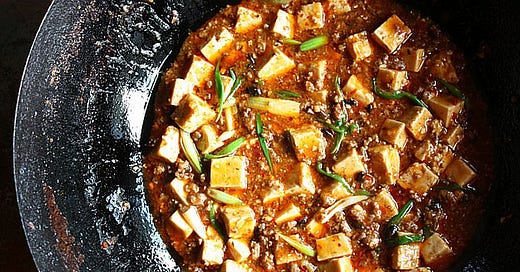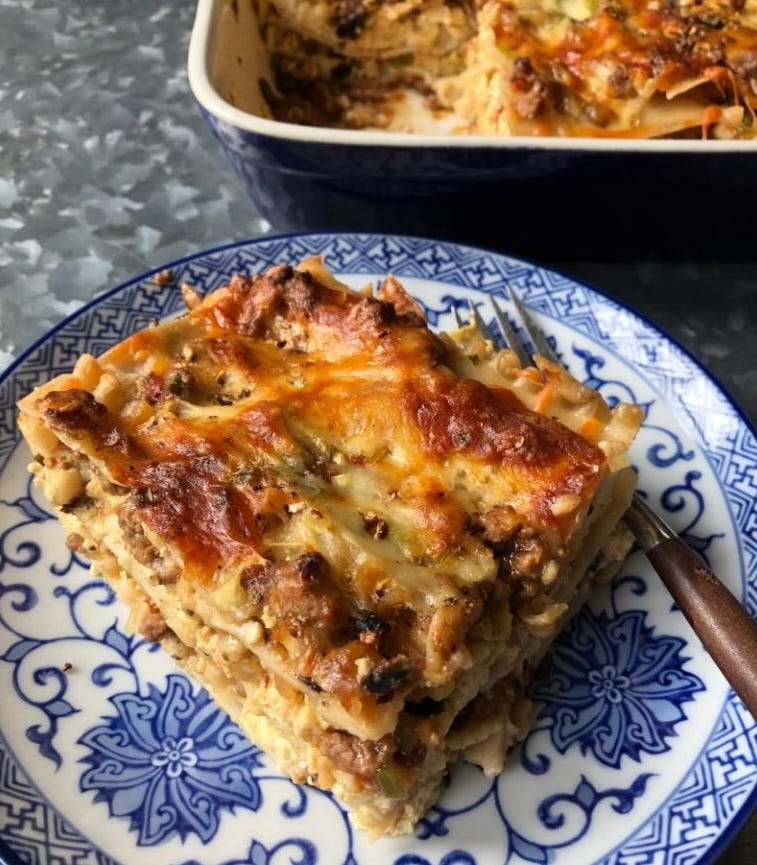Hello everyone!
Lots to to share with you today but it’ll be mostly about a Chinese classic, takeout icon, and one of my lifelong favorites — Mapo Tofu.
First up, we had a great Zoom meet up last week. I’m still figuring out scheduling and such so the event for paid subscribers will move around. The gathering is for paid subscribers but I’m sharing the Zoom playback with everyone to encourage you to join us as the PTFS community grows. It’s not just me doing the talking but we’re learning from one another.
To watch the playback:
Copy this passcode: cX8KV6F+
Then click on this link where you’ll be prompted for the code (I forgot to hit “Record” until we were 10 minutes in!)
Follow-up notes:
My stove info: It’s a GE Café, 30-inch range, dual fuel. More about it:
my 4-month review (After 3 years with the stove, I’m still happy with it.)
Countertop: Ceasarstone’s Statuario Nuvo in a honed finish
Rice: Dragron Red Blood variety mentioned by Marion
Jan. 2024 Zoom: In late January, let’s talk about fish sauce in our pantries and exchange notes. More on that next month. Join in!
Ever-Green Vietnamese news
The book has been named by food editors, writers, and bookshops as one the best cookbooks of 2023! I didn’t expect such a warm embrace of low-meat Viet cooking. I’d mentioned Epicurious and the Los Angeles Times earlier but since then, EGV has also been on the cookbook shortlists at the San Francisco Chronicle, National Post (in Canada), Good Housekeeping, Here and Now (WBUR/NPR), and Good Food (KCRW/NPR). Also, our local Bookshop Santa Cruz, which has a cookbook buyer who’s been in the biz for about 30 years, recommended EGV!
Thank you for supporting the book and cooking from it! And, if you haven’t, please leave a positive review at Amazon. Sharing your first-hand experiences matter a hella lot.
Let’s Make Mapo Magic
After I posted the Asian ingredient dispatch last week, I realized that I needed to add two other workhorses — Sichuan peppercorns and Chinese chile bean sauce. Those are used in many recipes that are classic and iconic. Now that we’re in the cooler time of the year, I’m reaching for the chile bean sauce (doubanjiang) to make my favorite tofu dish — mapo tofu.
I have go-toViet tofu dishes but if I had to choose only one Asian tofu dish, it would be mapo tofu. It’s simple, versatile, and lovable. It satisfies omnivores and herbivores alike.
My dad and his Taiwanese friend, Mr. Li, introduced me to mapo tofu in the early 1980s. Dad let me tag along for a lunch date he had with Mr. Li, a former banker from Taipei who wanted to live in Southern California so he and his wife bought a small motel in Laguna Beach. They were among the few Asians in our Southern California community. My dad taught ESL night classes got to know newcomers to the area like Mr. Li, who knew his way around a Chinese restaurant menu.
I was a junior high schooler and completely smitten by the spicy, slippery, and umami qualities of mapo tofu. I don’t recall the numbing zinginess of Sichuan peppercorns because from 1968 to 2005, the peppercorns were banned1 from the U.S.
But I was hooked. I partly studied Mandarin in college to get a firmer grasp of Chinese cuisine. It was a happy day when I could identify mapo tofu by its characters and order the dish well enough to charm native speakers. Here is an assist for you!
麻婆豆腐 mápó dòufu — How to pronounce the dish in Mandarin
I cooked many rounds of “Bean Curd with Hot Meat Sauce” from Irene Kuo’s Key to Chinese Cooking but didn’t start understanding mapo tofu until after Fuchsia Dunlop’s Sichuan cookbook, Land of Plenty, released (it was updated in 2019 with an SEO friendlier title — The Food of Sichuan.)
In 2010, I went to Chengdu, China, to do field research for my book, Asian Tofu. That’s where I tasted the real deal that had been passed down for generations from Mrs. Chen, the pock-marked older widow, chef and restaurateur who created the braised tofu recipe in the late 1800s during the Qing Dynasty2. What I learned since:
Meaning: The dish is strangely named to honor Mrs. Chen. “Ma” refers to pock-marked skin. “Po refers to an older woman, like a granny who is beloved. Mrs. Chen served the dish to many working class customers. Mapo tofu is a homey comfort food.
Tofu vs. doufu? Tofu was invented in China where it is called doufu. However, in the States, it goes by tofu, the term used in Japan. In The Soybean, published in 1923. author and researcher Charles Piper equivocates in referring to it as soybean curd, bean curd and tofu. He also provides the name in Chinese, Japanese and Vietnamese (Annamites). By 1945 when Mildred Lager published “The Useful Soybean,” tofu was the only term she used. Perhaps World War II had to do with the choice of terms?
Popularity: Mapo tofu is iconic and classic. It’s on Chinese restaurant menus in America but for many years, Cantonese classics eclipsed beloved Sichuan dishes. A regional focus on Chinese cooking has opened the door. In China, however, mapo tofu launched an empire for the Chen family. There are several locations to enjoy their rendition. I’ve also seen creative mapo lasagna too (scroll down for my recipe).
Kind and amount of meat: Ground or minced beef is the meat of choice in Chengdu. Sorry, it’s not pork but you can use different kinds of ground meat or even a meat alternative or mushroom. You can use as little as 2 or 3 ounces of ground meat for 12 ounces of tofu but many cooks abroad employ more meat.
Punchy flavors: It’s a rich, oily, very spicy dish in Sichuan so it’s wise to pair it with mild sides like a boiled or steamed green vegetable. (Sound menu planning advice from a Chinese literature professor who dined with us at Chen’s tofu in Chengdu.)
Required seasonings: There’s lots of leeway for seasoning mapo tofu but what’s not negotiable are fermented chile bean paste (doubanjiang) and Sichuan peppercorn. Together they create the spicy numbing characteristics that help to define mapo tofu. Ginger is usually in the mix as an aromatic and green onions finish the dish.
Flexible seasonings: I’ve seen recipes also include fermented black beans, garlic, sesame oil. You can play with mapo.
Type of tofu: For classic mapo tofu, I favor medium-firm or firm tofu because they soak up flavors well and are tender. Some people like the slithery qualities of silken tofu for its rich texture. You can choose.
Mapo Tofu Tool Kit
Ready to live your biggest best mapo tofu life? Some resources for your adventure:
Ingredients
Doubanjiang Chile Bean Paste buying guide — Required for mapo’s flavor!
Sichuan Peppercorn buying guide — There are several kinds to choose from.
Fermented black beans — Optional, but many people say it’s a must-have.
Recipes
My best Mapo Tofu — This is my go-to, no-fail recipe.
Vegan Mapo Tofu — Involves a fun way to manipulate tofu to mimic meat.
Mapo Lasagna — Let the Chinese icon loose on an Italian icon. It’s just a casserole! It’s a friendly potluck dish too!
No-Recipe-Needed Bonus: Leftover mapo tofu with rice and melty cheese in a flour tortilla is a bonkers burrito. Include Romaine lettuce ribbons for refreshing crunch, if you like.
Coming up on Sunday: Paid subscribers will receive four (4!) recipes involving a super fun take on mapo tofu that will hopefully cheer you as it has cheered me.
Florence Fabricant, “Sichuan's Signature Is Now Legal Again”, NYT, 2005.
Amanda Shephard, “What is Mapo Tofu and where did it get its ugly name?”, South China Morning Post, 2022.












mm cant wait to try the mapo lasagna! ive had a mapo pasta and was amazed how well the pasta and mapo tofu went together
I think I forgot to post my comments after tying them up in Notes... Ooops!
Thank you for answering my two questions. Regarding your countertops, is there a reason you chose honed over polished even though they’re harder to clean? Pure aesthetics?
I have a suggestion for Maia regarding “cat proofing” her lemongrass. I have lemongrass planted in the ground and right next to it I have catnip in a pot. We have three cats, plus rare visitors, and no one has ever messed with the lemongrass!
An enhanced version of your cookbooks? Please explain! Is this a different paper version or an online only situation?
My doubanjiang appears to be the brand Master and it’s made in Taiwan. It has the same characters on the label that you show in your pictures. Do I understand correctly that it’s less spicy but more umami forward? It’s the only one I’ve ever used.
Regarding people with an overwhelming excess of limes, have you reached out to food banks/organizations that share food with people in need? I’m sure they would be super stoked to receive an influx of limes. I know some cities have groups of people that will come out and pick your fruit if it is just going to go to waste. In the neighborhood my mom lives in, people will put baskets of fruit in their front yard for people to help themselves to.